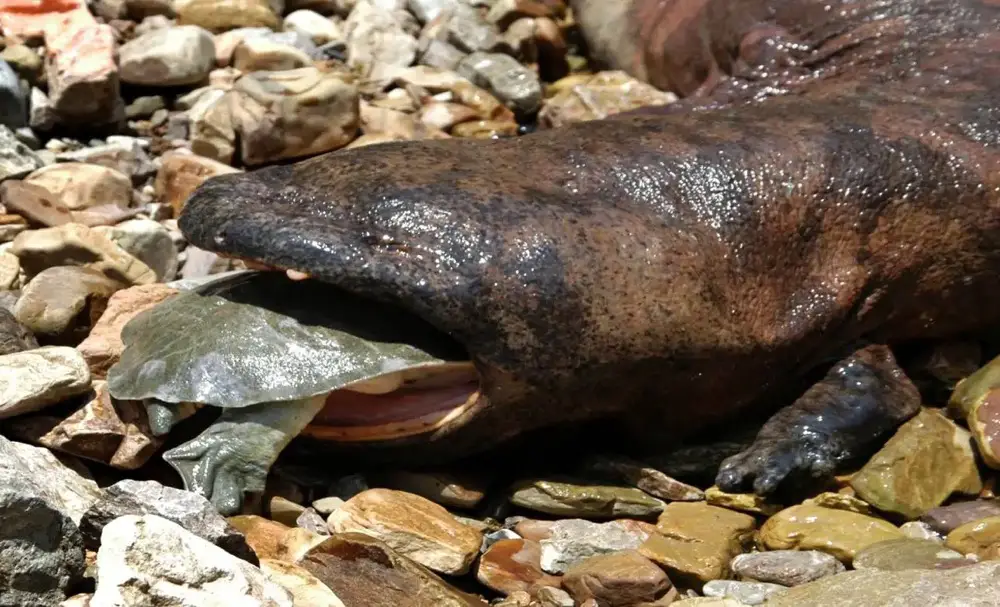If you have ever come across a giant Chinese salamander, you will agree that they are one of the most odd-looking creatures in the world. They look like regular salamanders, but the key difference is their size, color, and body shape.
They are mainly found in large fragmented regions in China and mostly live in fast-moving rivers, spend most of their days hidden in their dens, and mostly come out at night as they are nocturnal. Chinese salamanders are fully aquatic, unlike most amphibians, that grow to become terrestrial giants.
Giant Chinese salamanders are mystical creatures that are unknown to many. In this article, I will explain this animal’s details to help you understand it better.
Chinese giant salamander scientific name

The giant Chinese salamander’s scientific name is Andrias davidianus. It is the largest amphibian in the world. They are only found in large but fragmented regions in China, where they like staying in fast-moving rocky rivers to get enough oxygen.
Unlike most other amphibians that mature into terrestrial animals, the giant Chinese salamander is fully aquatic. They have one lung primarily used for buoyancy, although they have been seen coming up to the surface to take big gulps of air.
Its closest relative is the giant Japanese salamander, but the giant Chinese salamander is significantly larger and is more endangered than its Japanese counterparts.
Where does the Chinese giant salamander live
As the name suggests, the giant Chinese salamander can only be found in China, where locals refer to them as infant fish. If you are asking yourself why the intriguing name, this is because, unlike most other salamanders, the giant Chinese salamander can vocalize calls and sounds that mimic those of a human infant.
In China, they are found in large but fragmented regions in the country where they like living in rocky and fast-moving water. Giant salamanders are mostly nocturnal animals; hence they spend most of their days hidden out of sight in their dens, sleeping or guarding their brood of eggs.
Chinese giant salamander characteristics

When I first came across a giant Chinese salamander, I found myself having mixed reactions as I had never seen anything like it. This salamander was nothing like the regular salamanders that I was used to.
It has a long yet flattened body that is perfect for living in fast-moving Chinese rivers as this shape offers less resistance to the water flow. It is very dark in color and has very smooth and slimy skin, which helps it camouflage perfectly among the rocks in the rivers so as to avoid its predators.
The giant Chinese salamander has a large muscular paddle-like tail that it uses to swim in the strong river currents. Although it mostly walks along the river bed, the salamander can use its tail for short bursts of power in order to get away from predators when the need arises.
Even though the giant Chinese salamander is a fully aquatic animal, it has one lung that is primarily used for buoyancy in the water but can be used for breathing as they have been seen surfacing to take big gulps of air.
Being an aquatic animal, the giant Chinese salamander gets most of its oxygen from the water through long tubes known as capillaries that run along both sides of its body. This is what makes the sides of its body have those holds that you will notice so as to increase surface area for oxygen absorption.
Finally, the giant Chinese salamander has very small eyes on top of its head that is almost impossible to see; this makes it have very poor vision. However, they have a lateral line that they use to find fish in the water.
When was the Chinese giant salamander discovered
The giant Chinese salamander was discovered in 1924, and they were documented and described by George Edward Boulenger. However, these magnificent creatures have been around for thousands of years as fossils have been found dating back to the Jurassic period.
What is unique about the Chinese giant salamander
If you have ever come across one of these mystic creatures, you will definitely agree with me when I say it is a sight not to be forgotten easily. The giant Chinese salamander is the largest amphibian in the world which makes it pretty unique in my book.
It is also among the few amphibians that are fully aquatic even at the adult stages of their lives and normally don’t venture out of the water unless occasionally coming up for air. Their large flat bodies make them very unique as most other salamanders in the world have a round body shape.
Chinese giant salamander facts
Chinese giant salamander size
The giant Chinese salamanders are the world’s largest amphibians. This means that they are pretty big since their Japanese cousins are pretty big as well. They have been known to grow up to 1.9 meters long in length. This is very impressive, especially for an amphibian, as they can easily dwarf some humans.
Chinese giant salamander weight
Holding the title of the largest amphibian does not come easily as there are already large amphibians around the world. However, the giant Chinese salamander holds this title since they can weigh as much as 30 kg in captivity and not so much less in the wild.
Chinese giant salamander lifespan
Unlike most amphibians in the world, the giant Chinese salamanders live for many years, some even longer than most humans. In the wild, they have been known to live up to 30 years and live even longer in captivity, where they have been documented to have lived up to 60 years.
The difference in life expectancy between wild giant Chinese salamanders and captive giant Chinese salamanders is that the wild salamanders fend for themselves, where they may get sick and die and also face so many more threats, unlike their captive counterparts. Who enjoy the benefits of modern-day medicine and being protected against predators.
What do Chinese giant salamanders eat?
Giant Chinese salamanders are carnivorous animals, and this means that they mainly feed on meat or other live animals. In the wild, they feed on small fish, frogs, and other small aquatic life. They have also been known to feed on other small salamanders.
What are the predators of the Chinese giant salamander
The giant Chinese salamanders are some of the biggest predators in Chinese rivers; hence they do not have so many predators after them. However, humans are the biggest predators that face them since many locals see them as a delicacy and hunt them for their meat.
However, other wild and natural predators include red foxes, river otters, and weasels.
Why are Chinese giant salamanders important?

Giant Chinese salamanders are extremely important since they are the largest amphibian in existence today and are only found in a few regions in China. They are also used for medicinal purposes since locals use some of the parts of the animal to produce medicine for various ailments.
The giant Chinese salamander also plays a major role in the ecosystem it comes from as they are predators which feed on some invasive species, which disrupts the equilibrium of the ecosystem.
Why are Chinese giant salamanders endangered
The Chinese giant salamander is classified as a critically endangered species in the world. There are many factors that have led to the decrease in their numbers over the years. Some of the factors are:
In China, the only place they are found, the government is building many dams to produce power. This leads to the distraction of their natural habitat, and also many of them are killed in the construction process.
Their numbers have decreased because of increased hunting by locals since their meat is a delicacy, and they also use some parts of the animal for medicinal purposes.
Finally, pollution of rivers by industries has led to the death of many giant Chinese salamanders leading to a rapid decrease in their numbers.
All these factors have led to a decrease in their population, making these mystic animals critically endangered.
How many Chinese giant salamanders are left in the wild
The numbers of the giant Chinese salamanders have drastically declined over the years hence making them a critically endangered animal. Seeing one of these majestic creatures is almost impossible in the wild as their number is very low and is found in fewer regions of China. It is estimated that there are between 20 -50 thousand Chinese giant salamanders in the world.
However, conservation measures have been taken to breed the giant Chinese salamander in captivity and then release them back into the wild so as to help bring their numbers back from the brink of extinction.
Are Chinese giant salamanders dangerous?
Chinese giant salamanders are not dangerous animals since they are not toxic in any way, as they are even considered a delicacy by many locals.
They also pose no harm to human beings are they consider humans as predators and try to stay away from us. They primarily feed on crayfish and any other animals that can fit inside their mouths, even other small salamanders; hence they pose no threat to any of the livestock that we humans keep.
Conclusion
Giant Chinese salamanders are one-of-a-kind creatures that have roamed the surface of the earth long before humans. They have survived many catastrophic events, but humans seem to spell their end. However, with the right conservation measures, we can save this majestic animal from the brink of extinction.